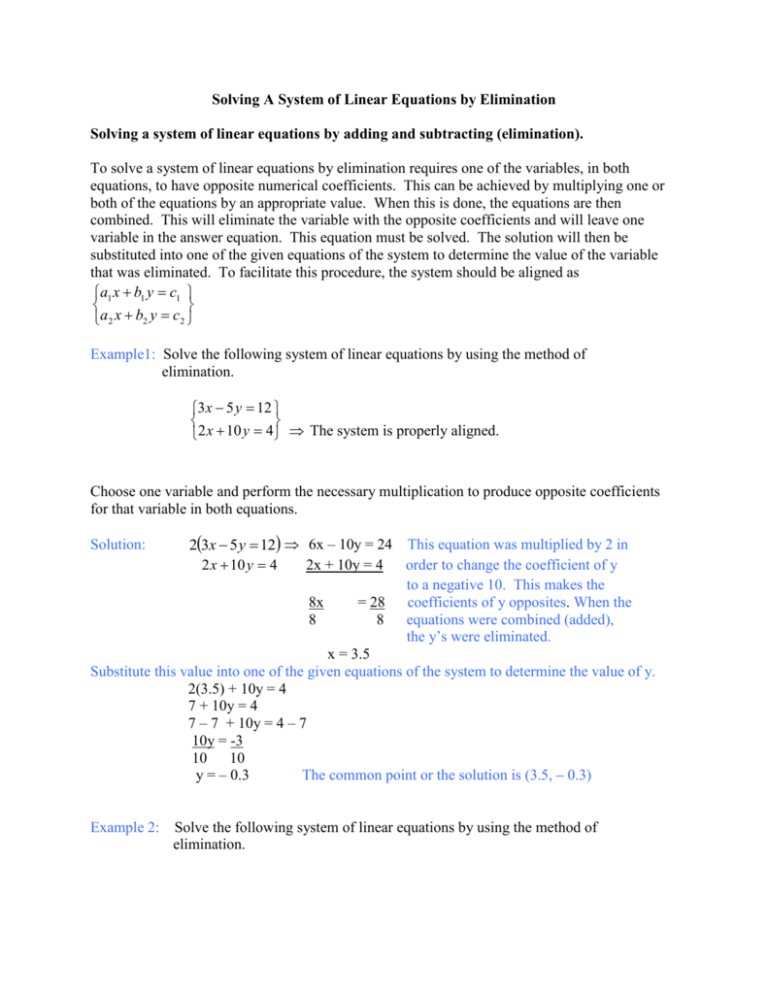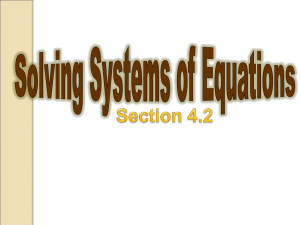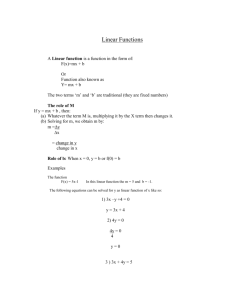Solving A System of Linear Equations by Elimination
advertisement

Solving A System of Linear Equations by Elimination Solving a system of linear equations by adding and subtracting (elimination). To solve a system of linear equations by elimination requires one of the variables, in both equations, to have opposite numerical coefficients. This can be achieved by multiplying one or both of the equations by an appropriate value. When this is done, the equations are then combined. This will eliminate the variable with the opposite coefficients and will leave one variable in the answer equation. This equation must be solved. The solution will then be substituted into one of the given equations of the system to determine the value of the variable that was eliminated. To facilitate this procedure, the system should be aligned as a1 x b1 y c1 a2 x b2 y c2 Example1: Solve the following system of linear equations by using the method of elimination. 3x 5 y 12 2 x 10 y 4 The system is properly aligned. Choose one variable and perform the necessary multiplication to produce opposite coefficients for that variable in both equations. 23x 5 y 12 6x – 10y = 24 This equation was multiplied by 2 in 2 x 10 y 4 2x + 10y = 4 order to change the coefficient of y to a negative 10. This makes the 8x = 28 coefficients of y opposites. When the 8 8 equations were combined (added), the y’s were eliminated. x = 3.5 Substitute this value into one of the given equations of the system to determine the value of y. 2(3.5) + 10y = 4 7 + 10y = 4 7 – 7 + 10y = 4 – 7 10y = -3 10 10 y = – 0.3 The common point or the solution is (3.5, – 0.3) Solution: Example 2: Solve the following system of linear equations by using the method of elimination. 2 x 9 y 1 4 x y 15 22 x 9 y 1 4 x y 15 4 x 18 y 2 4 x y 15 17 y 17 17 17 y 17 17 y 1 Substitute this value into one of the given equations of the system to determine the value of x. 4 x y 15 4 x 1 15 4 x 1 15 4 x 1 1 15 1 The common point or the solution is (4,-1) 4 x 16 4 16 x 4 4 x4 Example 3: Solve the following system of linear equations by using the method of elimination. 3x 2 y 9 0 4x 3y 5 3x 2 y 9 0 3x 2 y 9 9 0 9 4 x 3 y 3 y 3 y 5 4 x 3 y 5 3 x 2 y 9 4x 3y 5 3 x 2 y 9 The system is properly aligned. 4x 3y 5 9 x 6 y 27 33 x 2 y 9 8 x 6 y 10 24 x 3 y 5 17 x 17 17 x 17 17 17 x 1 Substitute this value into one of the given equations of the system to determine the value of y. 3x 2 y 9 0 3 1 2 y 9 0 3 2y 9 0 2y 6 0 2y 6 6 0 6 2 y 6 The common point or the solution is (-1,-3) 2 6 y 2 2 y 3 Example 4: Solve the following system of linear equations by using the method of elimination. 2 3 20 3 x 20 2 y 202 4 x 5 y 2 4 5 1 3 113 1 3 113 x y 14 x 14 y 14 7 7 2 7 2 7 215 x 8 y 40 152 x 21y 226 15 x 8 y 40 2 x 21y 226 30 x 16 y 80 30 x 315 y 3390 331 y 3310 331 3310 y 331 331 y 10 Substitute this value into one of the given equations of the system to determine the value of x. 3 2 x 10 2 4 5 3 x4 2 4 3 x44 24 4 3 x6 4 4 3 x 46 4 3 x 24 The common point or the solution is (8,10) 3 24 x 3 3 x8 Exercises: Solve the following system of linear equations by using the method of elimination. 16 x y 181 0 1. 19 x y 214 3 26 x y 4. 5 5 4 y 61 7 x x 69 6 y 2. 3x 4 y 45 x 7 y 38 3. 14 y x 46 Solutions: x 3 y 15 0 1. 7 y 3x 21 Comparison Method x 3 y 15 0 x x 3 y 15 0 x 3 y 15 15 x 15 7 y 3x 21 7 y 3x 3x 3 x 21 7 y 3x 21 7 3 21 y x 7 7 7 3 y x3 7 3 y x 15 3 1 15 y x 3 3 3 1 y x5 3 1 3 x5 x3 3 7 1 3 21 x 215 21 x 213 3 7 7 x 105 9x 63 7 x 105 105 9x 63 105 7 x 9x 42 7 x 9x 9x 9x 42 2x 42 2 42 x 2 2 x 21 1 x5 3 1 y 21 5 3 y 75 y 12 y The solution is (21, 12) x 3 y 11 2. 3x 2 y 30 x 3 y 11 x 3 y 3 y 3 y 11 x 3 y 11 Substitution Method x 3 y 11 x 3 9 11 x 27 11 x 16 3 x 2 y 30 3 3 y 11 2 y 30 9 y 33 2 y 30 7 y 33 30 7 y 33 33 30 33 7 y 63 7 63 y 7 7 y 9 The solution is (16,-9). 2 x y 7 0 3. x 2 y 1 0 2x y 7 0 2x 2x y 7 0 2x y 7 2 x y 7 7 2 x 7 y 2 x 7 x 2y 1 0 x x 2y 1 0 x 2 y 1 x 2 y 1 1 x 1 2 y x 1 2 1 1 y x 2 2 2 1 1 y x 2 2 Graphing Method Following is the graph of y 2 x 7 and y 1 1 x . 2 2 The solution is the point of intersection (3, 1). Solutions: Elimination Method 16 x y 181 0 1. 19 x y 214 16 x y 181 0 16 x y 181 181 0 181 16 x y 181 16 x y 181 19 x y 214 16 x y 181 19 x y 214 3x 33 3 33 x 3 3 x 11 The solution is (11, -5). 1(16 x y 181) 19 x y 214 16 x y 181 16(11) y 181 176 y 181 176 176 y 181 176 1 5 y 1 1 y 5 x 69 6 y 2. 3x 4 y 45 x 69 6 y x 6 y 69 6 y 6 y x 6 y 69 x 6 y 69 3 x 4 y 45 3 x 4 y 45 3 x 4 y 45 4 y 3 x 4 y 45 3( x 6 y 69) 3 x 4 y 45 3x 18 y 207 3x 4 y 45 14 y 252 14 252 y 14 14 y 18 x 69 6 y x 69 6(18) x 69 108 x 39 The solution is (-39, -18) x 7 y 38 3. 14 y x 46 x 7 y 38 x 7 y 7 y 7 y 38 x 7 y 38 14 y x 46 14 y x x x 46 x 14 y 46 x 7 y 38 x 14 y 46 2 x 14 y 76 x 14 y 46 2( x 7 y 38) x 14 y 46 3x 30 3 30 x 3 3 x 10 x 7 y 38 10 7 y 38 10 38 7 y 38 38 28 7 y 28 7 y 7 7 4 y The solution is (10, -4). 3 26 x y 4. 5 5 4 y 61 7 x 3 26 y 5 5 3 26 5 x 5 y 5 5 5 5 x 3 y 26 x 5 x 3 y 26 7 x 4 y 61 4 y 61 7 x 4 y 7 x 61 7 x 7 x 7 x 4 y 61 4(5 x 3 y 26) 3(7 x 4 y 61) 20 x 12 y 104 21x 12 y 183 41x 287 41 287 x 41 41 x7 The solution is (7, 3) 4 y 61 7 x 4 y 61 7(7) 4 y 61 49 4 y 12 4 12 y 4 4 y3









